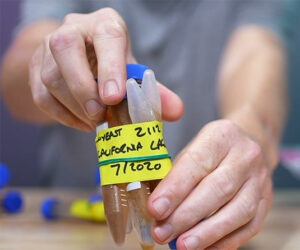Learn the Rules of Pitching
There are few things more defeating to a homebrewer than to check on the fermenter containing sweet wort crafted two days earlier, only to find no signs of life in the fermenter. So let’s go through the rules of yeast to get you on the road to pitching a perfect game.
RULE #1 — Hone Your Best Pitch
Homebrewers have two main groupings of yeast to choose from, dry and liquid yeast. Dry yeast is popular due to low cost, longer shelf life, ease of use and ability to withstand extreme temperatures during shipping. The downside being there is not as wide a range of strains to choose from. Most dry yeast for homebrewers come in 11-gram sachets, but you will find sachets of differing amounts. There are about 20 billion cells of yeast per gram of dry yeast. A general rule of thumb is that one 11-gram sachet is perfect for most 5-gallon (19-L) ales while two sachets should be used for lagers.
Liquid yeast are popular due to the huge selection available. The downside is that oftentimes liquid yeast require a starter, shelf life is much shorter, they don’t handle temperature extremes well, and are more expensive. Re-using liquid yeasts once they get going though is popular and can help offset the higher cost. Wyeast Activator and White Labs PurePitch both have about 100 billion yeast cells when packaged, but recognize that count goes down the older the package gets. Other manufacturers have different counts, so be sure to check manufacturer’s estimated yeast counts if you are using a different yeast company.
RULE #2 — The Reliever
Every homebrewer should keep in their fridge at least one extra sachet (the reliever) of dry yeast to break open in case of emergency. Even an ace yeast pitcher can have a bad day. I generally will give the wort 48 hours and if there is no sign of life, then go to the reliever.
RULE #3 — Warm Up and Cool Down
Yeast don’t like to be shocked and extreme temperature swings can cause off-flavors and even yeast death. There are many ways to stress the yeast during fermentation, but temperature stress during pitching is an easy one to avoid. Use a thermometer and always give yeast a proper warm up or cool down so that when it’s time to pitch, the yeast is ± 5 °F (2.5 °C) of the wort.
RULE #4 — Know Your Pitch Count
Most homebrewers should learn the term M cells/mL/°P. This is a phrase explaining how much yeast you should be pitching given your wort’s volume and starting gravity. So let’s take a quick spin through this concept. Say you have a recipe that indicates pitching 0.5 M cells/mL/°P and you need to figure out how much that means for a 5-gallon (19-L) batch you are brewing next week. The °P = degrees Plato and is easily calculated by dividing your estimated original gravity by 4. So if you are hoping for 1.056, that means about 14 °P. Next 5 gal. = 19 L and the beauty of metrics is that 19 L = 19,000 mL. Finally the 0.5 M cells = 500,000 cells of yeast. Now you just need to plug into a calculator 500,000 x 19,000 x 14 = 133,000,000,000 or 133 billion cells. Now go back to see how that compares to how much yeast is in the package.
The 0.5 M cells/mL/°P is a good general guideline for most ales. Go higher for high gravity or ales you want cleaner like an American pale ale or Kölsch. Go lower for low gravity ales or ales you want more expressive like a hefeweizen or bitter. Lagers will generally require more yeast, but very similar dynamics. A good starting point for a lager is 1.25 M cells/mL/°P.
RULE #5 — Find Your Zen
If you use dry yeast, you don’t have to rehydrate your yeast, but the osmotic stress can cause yeast die-off when you sprinkle the dry yeast on the wort. If you do rehydrate your yeast, please follow the manufacturer’s instructions and use a thermometer to watch for temperature stress.
If you use liquid yeast and need to make a starter, don’t overcomplicate things. Find a good yeast growth calculator online and stick with a simple 10% starter solution: 100 g of dried malt extract to 1 L of water. Add a pinch of yeast nutrients and a drop of FermCap in solution when boiling and place in a clear container, placing aluminum foil over the top. Older yeast can take a while before they get going, so be patient and watch for yeast activity. If you were diligent about sanitation, contamination from outside organisms should not be an issue.
Now get out there and be a master of the pitch!



